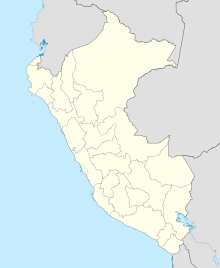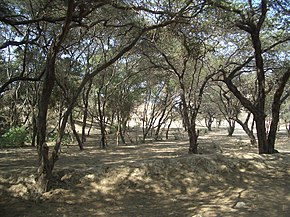Pyramids of Túcume
The pyramids of Túcume are located near the city of Túcume in the administrative region of Lambayeque , the "Departamento de Lambayeque" in northern Peru , on an area of approx. 220 hectares. They are the largest known collection of pyramids made of unfired clay bricks from pre-Columbian times . The locals also call the historic site Purgatorio , or purgatory . There are 26 great pyramids counted; in total there are about 260 pieces in this area. The highest currently measures around 30 m and is called " Huaca 1". Even more impressive in terms of size is the "Huaca Larga", which is one of the largest pyramids in the world with a floor plan of 700 by 280 meters. (For comparison: Cheops pyramid 230 m × 230 m; Pyramid of Cholula 450 m × 450 m.) The archaeologists assume that the pyramids were built around 1100 for religious rituals, when the Sicán due to the decline of the Mochica culture expanded by 700 power vacuums created in the Lambayeque Valley. It is believed that the Lambayeque, Central American indigenous people of the Sicán culture, maintained an extensive administrative , military and religious center in this area .
Geographical location
Coordinates: 6 ° 30 ′ 57 ″ S , 79 ° 50 ′ 39 ″ W
The archaeological site, also known as " El Valle de las Piramides " (Spanish for "Valley of the Pyramids"), is located in a valley not far from the Peruvian coastal region in what is now the administrative district of Lambayeque, just over 30 kilometers from the city of Chiclayo on La Raya Mountain not far from the town of Túcume. The landscape of the Peruvian coast is essentially a desert landscape interspersed with river oases . There are also some dry forests near Túcume , a very fragile biotope (Fig. 4). As this region is crossed by several rivers, it was an ideal cultural area for the indigenous people. However, it forced the residents to develop high levels of land irrigation in order to still be able to use the land for agriculture at some distance from the rivers.
Cultural classification
The pyramids discovered in Túcume, especially the larger ones, are so-called Huacas - temple mountains (Spanish: Huaca , ketschua : wak'a ). Huacas were originally built by the Mochica, whose peripheral sphere of influence on the coast of Peru extended as far as Túcume. In the 8th century, the Mochica culture perished for reasons that are still unknown, and a power vacuum developed in the valleys previously populated by the Mochica. In this phase the Sicán , possibly the descendants of the Mochica, settled the valley. Túcume is mainly assigned to the Lambayeque culture , a subgroup of the late Sicán in the period from 1000 to 1350 AD, who settled here after they had given up their previous center of Poma in the upper Leche Valley.
Around 1350 AD the Chimú took over the area along the coast for about a century until 1470. The rapidly expanding Inca , who under Túpac Inka extended their sphere of influence from the south into the area of today's Peru and finally also occupied Ecuador and Bolivia , ruled Túcume from 1470 to 1532. The arrival of the Spanish conquistadors in search of gold from the South American continent ended the rule of the Inca. Túcume was finally abandoned between 1532 and 1547.
Building designation
The term pyramids is not very aptly chosen in this context, since the larger specimens are temple mountains, with Huaca ( wak'a ) in the original sense meaning something revered, a holy place or something similar. In the upper town , on the platform of the great Huacas, lived the nobles, priests and ruling families in the Lambayeque society, which was already organized into classes. In addition, the platform of a temple mount was often surmounted by another elevation on which the holy district was formerly located (Fig. 3).
Archaeological excavations
The German engineer, ethnographer and linguist Heinrich "Enrique" Brüning accidentally found ruins of the Huacas and is considered to be the first researcher in this region. A number of early Huacas photographs were taken by him. He devoted himself to research into the historical Muchik language spoken by the local people of the area. His archaeological finds formed the basis for the Museo Nacional Enrique Bruning de Lambayeque in Lambayeque, which is named after him . Further archaeological research on the Huacas of Túcume was carried out by Thor Heyerdahl , who was looking for the grave of Naymlap (= "water bird") to prove its origin over the sea, as part of a project from 1988 to 1993.
Due to the late onset of scientific research, which essentially did not begin until the 1990s, many questions remain unanswered. Examples are the cause of Túcume's decline, the massive traces of fire, the discovery of over a hundred skeletons, obviously human victims, not far from the Huaca Larga. The search for the grave of the legendary Naymlap, one of the most important rulers of the region and the legend of the founder of the Lambeyeque culture, has so far been unsuccessful. Another problem is that excavations destroy the conservative cover layers. The tropical downpours caused by El Niño cause severe erosion on the surface of the Huacas anyway (Fig. 5). This complicates the work of archaeologists and additionally limits their progress.
Public and museum
The "Valley of the Pyramids" can be visited. Both a visitor center and a museum, the Museo de Sitio Túcume , are available for further information.
Individual evidence
- ^ A b Christopher Scarre , Brian M. Fagan : Ancient Civilizations. Prentice Hall, 2002, p. 505. ISBN 0-13-048484-9
- ^ Chronological sequence of colonization by Helaine Silverman, William Isbell: Handbook of South American Archeology , Springer, 2008, p. 764, table: Chronologies of the coastal Regions. ISBN 0-387-74906-3
- ↑ Enjoy Peru - Travel information : Bosque de Pomac in Spanish. Last accessed July 7, 2008
- ^ Media Peru: Map of the area Last accessed on July 6, 2008
- ↑ Literature about the Chimú ( page no longer available , search in web archives ) Info: The link was automatically marked as defective. Please check the link according to the instructions and then remove this notice. in the catalog of the Ibero-American Institute in Berlin
- ↑ Túcumes official website: Datos Generales in Spanish. Last accessed July 7, 2008
- ↑ HH Brüning: Estudios monográficos del Departamento de Lambayeque. Fascículos I-IV. Chiclayo 1922-23
- ↑ A thematic compilation of Brüning's photographs can be found in C. Raddatz (ed.): Photo documents from Northern Peru by Hans Heinrich Brüning (1848–1928). Pages 21-24, Hamburg 1990
- ↑ For example ZDF Expedition: Scenarios of Downfall ( page no longer available , search in web archives ) Info: The link was automatically marked as defective. Please check the link according to the instructions and then remove this notice. Last accessed July 7, 2008
literature
- Thor Heyerdahl : The pyramids of Túcume , 1995, ISBN 3-7844-2535-6
- Thor Heyerdahl: Túcume , Lima 1996. (Spanish)
- Thor Heyerdahl; Daniel H. Sandweiss, A. Navarez y L. Milliones: Túcume , Banco de Crédito del Perú, Lima 1996, (span.)
- Thor Heyerdahl; Daniel H. Sandweiss y A. Navarez: Pyramids of Tucume. The Quest for Perú's Forgotten City. Thames and Hudson, New York 1995, (English)
- Helaine Silverman, William Isbell: Handbook of South American Archeology , Springer, 2008, ISBN 0-387-74906-3





